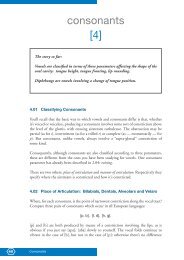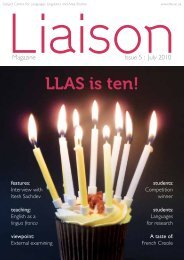PHONETICS MANUAL.indd - HumBox
PHONETICS MANUAL.indd - HumBox
PHONETICS MANUAL.indd - HumBox
You also want an ePaper? Increase the reach of your titles
YUMPU automatically turns print PDFs into web optimized ePapers that Google loves.
66. With reference to as many as possible of the following languages (in their<br />
standard version), say whether these sounds are part of the repertoire or not:<br />
English, French, German, Spanish. [x], [ç], [?], [q], [h].<br />
4.07 Aspirates<br />
Here’s an final point about stops which has been kept from you so far. But it should be<br />
noted, as it’s another important difference between English and German on the one<br />
hand, French, Spanish and Italian on the other.<br />
Say the English word pa very slowly, clearly and deliberately. You may notice that the<br />
[A] vowel doesn’t begin immediately after stage (3) of the stop (the “release” stage).<br />
Instead there’s a short pause before the vocal folds begin to vibrate, during which<br />
air passes freely through the glottis. Hence the effect of a puff of breath, or brief [h]<br />
sound, between the [p] and the vowel. The same applies to the other voiceless stops,<br />
e.g. in tar or car.<br />
If the same syllables are pronounced in the French, Spanish or Italian way, the vowels<br />
begin immediately after the release of the [p], [t] or [k] — no delay, so no suggestion<br />
of a puff of breath or an [h]. It is incorrect in these languages to delay the onset of the<br />
vowel.<br />
Voiceless stops followed by a puff of breath (more technically “followed by delayed<br />
vowel onset”) are said to be aspirated. Those without the “aspiration” are — obviously<br />
— said to be unaspirated. The IPA uses a superscript h to indicate aspiration: [p h ], [t h ],<br />
[k h ], but there’s no need to include this detail in an ordinary transcription of English.<br />
Diagramatically the process can be represented as follows (aspirated stop in Fig. 33,<br />
unaspirated stop in Fig. 34):<br />
Fig. 33<br />
release<br />
p h<br />
A:<br />
aspiration<br />
voicing<br />
Fig. 34<br />
release<br />
p<br />
A:<br />
voicing<br />
52 Consonants






